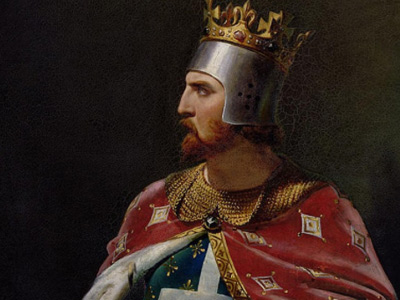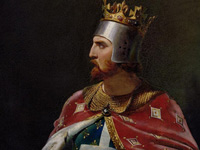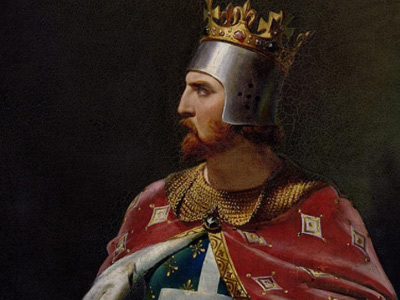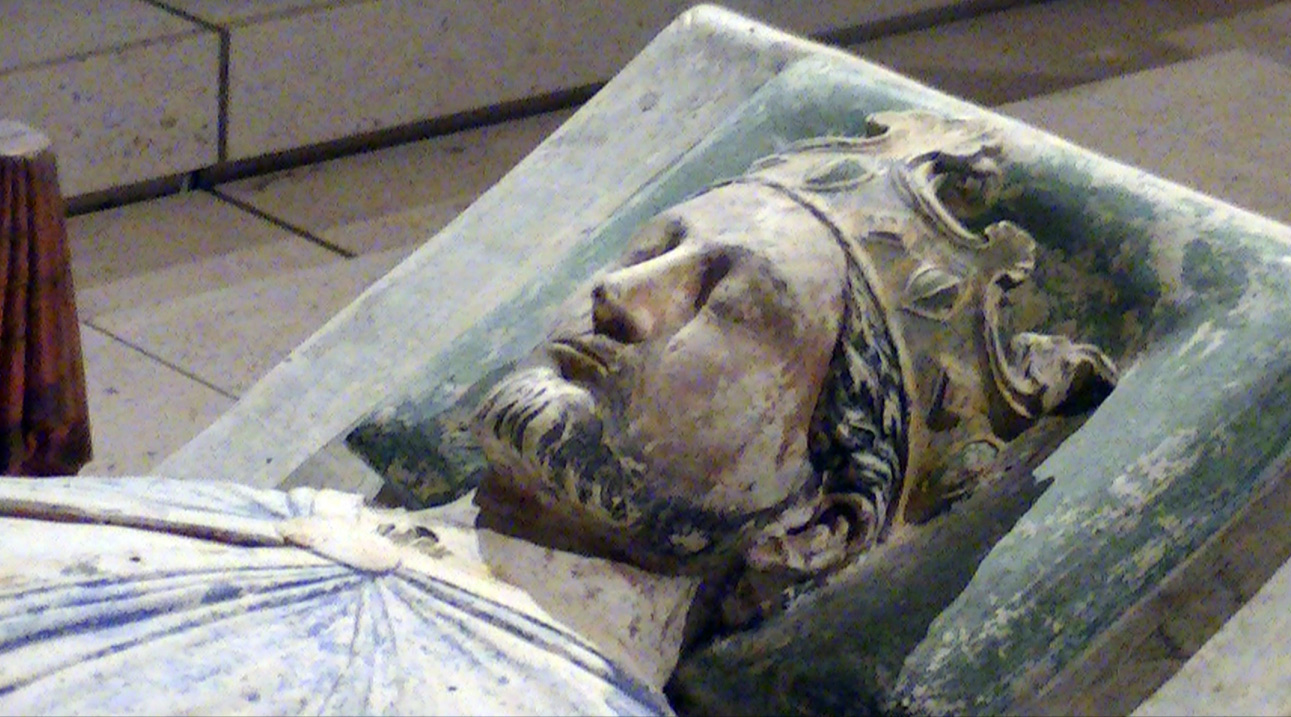Richard I of England (1157-1199)

Childhood
Richard was born on 8 September 1157, probably at Beaumont Palace, in Oxford, England, son of King Henry II and Eleanor of Aquitaine. He was a younger brother of Count William IX of Poitiers, Henry the Young King and Duchess Matilda of Saxony. As the third legitimate son of King Henry II, he was not expected to ascend the throne. He was also an elder brother of Duke Geoffrey II of Brittany; Queen Eleanor of Castile; Queen Joan of Sicily; and Count John of Mortain, who succeeded him as king. Richard was the younger maternal half-brother of Countess Marie of Champagne and Countess Alix of Blois. The eldest son of Henry II and Eleanor, William, died in 1156, before Richard's birth. Richard is often depicted as having been the favourite son of his mother. His father was Angevin-Norman and great-grandson of William the Conqueror. Contemporary historian Ralph of Diceto traced his family's lineage through Matilda of Scotland to the Anglo-Saxon kings of England and Alfred the Great, and from there linked them to Noah and Woden. According to Angevin legend, there was even infernal blood in the family.
While his father visited his lands from Scotland to France The Kingdom of France is the historiographical name or umbrella term given to various political entities of France in the medieval and early modern period. It was one of the most powerful states in Europe since the High Middle Ages. It was also an early colonial power, with possessions around the world. Colonial conflicts with Great Britain led to the loss of much of its North American holdings by 1763. The Kingdom of France adopted a written constitution in 1791, but the Kingdom was abolished a year later and replaced with the First French Republic., Richard probably spent his childhood in England
The Kingdom of France is the historiographical name or umbrella term given to various political entities of France in the medieval and early modern period. It was one of the most powerful states in Europe since the High Middle Ages. It was also an early colonial power, with possessions around the world. Colonial conflicts with Great Britain led to the loss of much of its North American holdings by 1763. The Kingdom of France adopted a written constitution in 1791, but the Kingdom was abolished a year later and replaced with the First French Republic., Richard probably spent his childhood in England The Kingdom of England was a sovereign state on the island of Great Britain from about 927, when it emerged from various Anglo-Saxon kingdoms, until 1 May 1707, when it united with Scotland to form the Kingdom of Great Britain. The Viking invasions of the 9th century upset the balance of power between the English kingdoms, and native Anglo-Saxon life in general. The English lands were unified in the 10th century in a reconquest completed by King Æthelstan in 927.. His first recorded visit to the European continent was in May 1165, when his mother took him to Normandy. His wet nurse was Hodierna of St Albans, whom he gave a generous pension after he became king. Little is known about Richard's education. Although he was born in Oxford and brought up in England up to his eighth year, it is not known to what extent he used or understood English; he was an educated man who composed poetry and wrote in Limousin (lenga d'òc) and also in French. During his captivity, English prejudice against foreigners was used in a calculated way by his brother John to help destroy the authority of Richard's chancellor, William Longchamp, who was a Norman. One of the specific charges laid against Longchamp, by John's supporter Hugh, Bishop of Coventry, was that he could not speak English. This indicates that by the late 12th century a knowledge of English was expected of those in positions of authority in England.
The Kingdom of England was a sovereign state on the island of Great Britain from about 927, when it emerged from various Anglo-Saxon kingdoms, until 1 May 1707, when it united with Scotland to form the Kingdom of Great Britain. The Viking invasions of the 9th century upset the balance of power between the English kingdoms, and native Anglo-Saxon life in general. The English lands were unified in the 10th century in a reconquest completed by King Æthelstan in 927.. His first recorded visit to the European continent was in May 1165, when his mother took him to Normandy. His wet nurse was Hodierna of St Albans, whom he gave a generous pension after he became king. Little is known about Richard's education. Although he was born in Oxford and brought up in England up to his eighth year, it is not known to what extent he used or understood English; he was an educated man who composed poetry and wrote in Limousin (lenga d'òc) and also in French. During his captivity, English prejudice against foreigners was used in a calculated way by his brother John to help destroy the authority of Richard's chancellor, William Longchamp, who was a Norman. One of the specific charges laid against Longchamp, by John's supporter Hugh, Bishop of Coventry, was that he could not speak English. This indicates that by the late 12th century a knowledge of English was expected of those in positions of authority in England.
Richard was said to be very attractive; his hair was between red and blond, and he was light-eyed with a pale complexion. He was apparently of above average height: according to Clifford Brewer he was 6 feet 5 inches (1.96 m). As with his supposed lack of English, the question of his stature is one made from a lack of evidence as his remains have been lost since at least the French Revolution, and his exact height is unknown. John, his youngest brother (by the same father and mother), was known to be 5 feet 5 inches (1.65 m). The Itinerarium peregrinorum et gesta regis Ricardi, a Latin prose narrative of the Third Crusade, states that: "He was tall, of elegant build; the colour of his hair was between red and gold; his limbs were supple and straight. He had long arms suited to wielding a sword. His long legs matched the rest of his body".
From an early age he showed significant political and military ability, becoming noted for his chivalry and courage as he fought to control the rebellious nobles of his own territory. His elder brother Henry the Young King was crowned king of England during his father's lifetime.
Marriage alliances were common among medieval royalty: they led to political alliances and peace treaties, and allowed families to stake claims of succession on each other's lands. In March 1159 it was arranged that Richard would marry one of the daughters of Ramon Berenguer IV, Count of Barcelona; however, these arrangements failed, and the marriage never took place. Henry the Young King was married to Margaret, daughter of Louis VII of France, on 2 November 1160. Despite this alliance between the Plantagenets and the Capetians, the dynasty on the French throne, the two houses were sometimes in conflict. In 1168, the intercession of Pope Alexander III was necessary to secure a truce between them. Henry II had conquered Brittany and taken control of Gisors and the Vexin, which had been part of Margaret's dowry.
Early in the 1160s there had been suggestions Richard should marry Alys, Countess of the Vexin (Alice), fourth daughter of Louis VII; because of the rivalry between the kings of England and France, Louis obstructed the marriage. A peace treaty was secured in January 1169 and Richard's betrothal to Alys was confirmed. Henry II planned to divide his and Eleanor's territories among their three eldest surviving sons: Henry would become King of England and have control of Anjou, Maine, and Normandy; Richard would inherit Aquitaine and Poitiers from his mother; and Geoffrey would become Duke of Brittany through marriage with Constance, heir presumptive of Conan IV. At the ceremony where Richard's betrothal was confirmed, he paid homage to the King of France for Aquitaine, thus securing ties of vassalage between the two.
After Henry II fell seriously ill in 1170, he put in place his plan to divide his kingdom, although he would retain overall authority over his sons and their territories. In 1171 Richard left for Aquitaine with his mother, and Henry II gave him the duchy of Aquitaine at the request of Eleanor. Richard and his mother embarked on a tour of Aquitaine in 1171 in an attempt to pacify the locals. Together they laid the foundation stone of St Augustine's Monastery in Limoges. In June 1172 Richard was formally recognised as the Duke of Aquitaine when he was granted the lance and banner emblems of his office; the ceremony took place in Poitiers and was repeated in Limoges, where he wore the ring of St Valerie, who was the personification of Aquitaine.
HISTORY

RESOURCES
This article uses material from the Wikipedia article "Richard I of England (1157-1199)", which is released under the Creative Commons Attribution-Share-Alike License 3.0.
© Stories Preschool. All Rights Reserved.










